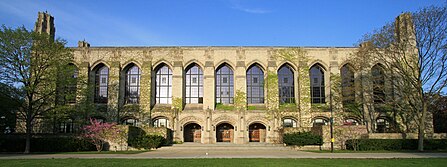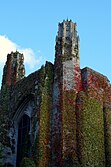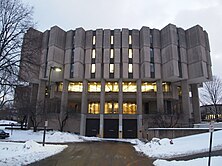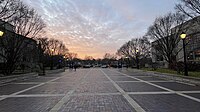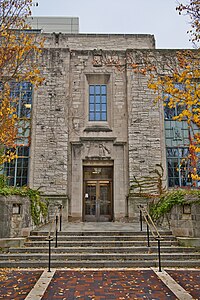
A | B | C | D | E | F | G | H | CH | I | J | K | L | M | N | O | P | Q | R | S | T | U | V | W | X | Y | Z | 0 | 1 | 2 | 3 | 4 | 5 | 6 | 7 | 8 | 9
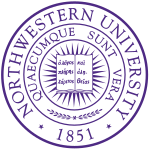 | |
| Latin: Universitas Northwestern | |
| Motto | |
|---|---|
Motto in English | "Whatsoever things are true" (Philippians 4:8 AV) "The Word full of grace and truth" (John 1:14) |
| Type | Private research university |
| Established | January 28, 1851 |
| Accreditation | HLC |
Academic affiliations | |
| Endowment | $16.1 billion (2022)[1] |
| Budget | $2.9 billion (2022) (excluding the health system)[1] |
| President | Michael Schill |
| Provost | Kathleen Hagerty |
Academic staff | 4,018 (Fall 2021)[2] |
| Students | 23,410 (Fall 2021)[3] |
| Undergraduates | 8,816 (Fall 2021)[3] |
| Postgraduates | 14,684 (Fall 2021)[3] |
| Location | , , 42°03′21″N 87°40′29″W / 42.05583°N 87.67472°W |
| Campus | Small city[4], 240 acres (97 ha) |
| Other campuses | |
| Newspaper | The Daily Northwestern |
| Colors | Purple and white[5] |
| Nickname | Wildcats |
Sporting affiliations |
|
| Mascot | Willie the Wildcat |
| Website | northwestern.edu |
Northwestern University (NU) is a private research university in Evanston, Illinois. Established in 1851 to serve the historic Northwest Territory, it is the oldest chartered university in Illinois. The university has its main campus along the shores of Lake Michigan in the Chicago metropolitan area.
Chartered by the Illinois General Assembly in 1851, Northwestern was initially affiliated with the Methodist Episcopal Church but later became non-sectarian. By 1900, the university was the third-largest university in the United States. Northwestern became a founding member of the Big Ten Conference in 1896 and joined the Association of American Universities in 1917.
Northwestern is composed of eleven undergraduate, graduate, and professional schools which includes Kellogg School of Management, McCormick School of Engineering and Applied Sciences among others. In addition to the Evanston campus, it has campuses in downtown Chicago, Coral Gables, San Francisco, Doha, and Washington, D.C.
As of 2023, the university had an endowment of $14.1 billion, an annual budget of around $2.9 billion,[6][7] and research funding of over $1 billion.[8] The university fields 19 intercollegiate athletic teams, the Northwestern Wildcats, which compete in the NCAA Division I in the Big Ten Conference.
As of September 2020, 33 Nobel Prize laureates and 2 Fields Medalists[9] have been affiliated with Northwestern as alumni or faculty. In addition, Northwestern has been associated with 47 Pulitzer Prize winners, 23 National Medal of Science winners, 11 National Humanities Medal recipients, 23 MacArthur Fellows, 20 Rhodes Scholars,[10] and 28 Marshall Scholars. Northwestern alumni also include 10 living billionaires,[11] 2 U.S. Supreme Court Justices,[12][13] and 24 Olympic medalists.
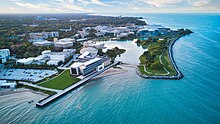
History
Founding and early years
The foundation of Northwestern University can be traced to a meeting on May 31, 1850, of nine prominent Chicago businessmen, Methodist leaders, and attorneys who had formed the idea of establishing a university to serve what had been known from 1787 to 1803 as the Northwest Territory. On January 28, 1851, the Illinois General Assembly granted a charter to the Trustees of the North-Western University, making it the first chartered university in Illinois.[14][15] The school's nine founders, all of whom were Methodists (three of them ministers), knelt in prayer and worship before launching their first organizational meeting.[16] Although they affiliated the university with the Methodist Episcopal Church, they favored a non-sectarian admissions policy, believing that Northwestern should serve all people in the newly developing territory by bettering the economy in Evanston.[17]
John Evans, for whom Evanston is named, bought 379 acres (153 ha) of land along Lake Michigan in 1853, and Philo Judson developed plans for what would become the city of Evanston, Illinois. The first building, Old College, opened on November 5, 1855.[18] To raise funds for its construction, Northwestern sold $100 "perpetual scholarships" entitling the purchaser and his heirs to free tuition.[19][20] Another building, University Hall, was built in 1869 of the same Joliet limestone as the Chicago Water Tower, also built in 1869, one of the few buildings in the heart of Chicago to survive the Great Chicago Fire of 1871.[21]
In 1873 the Evanston College for Ladies merged with Northwestern, and Frances Willard, who later gained fame as a suffragette and as one of the founders of the Woman's Christian Temperance Union (WCTU), became the school's first dean of women (Willard Residential College, built in 1938, honors her name). Northwestern admitted its first female students in 1869, and the first woman graduated in 1874.[22] Northwestern fielded its first intercollegiate football team in 1882, later becoming a founding member of the Big Ten Conference. In the 1870s and 1880s, Northwestern affiliated itself with already existing schools of law, medicine, and dentistry in Chicago. The Northwestern University Pritzker School of Law is the oldest law school in Chicago. As the university's enrollments grew, these professional schools were integrated with the undergraduate college in Evanston; the result was a modern research university combining professional, graduate, and undergraduate programs, which gave equal weight to teaching and research.[23][24]
20th century
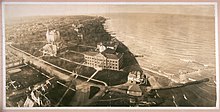
By the turn of the century, Northwestern had grown in stature to become the third-largest university in the United States after Harvard University and the University of Michigan.[25] Under Walter Dill Scott's presidency from 1920 to 1939, Northwestern began construction of an integrated campus in Chicago designed by James Gamble Rogers, noted for his design of the Yale University campus, to house the professional schools. In addition, James Gamble Rogers designed a library in accordance with the gothic architectural style on the Evanston campus in order to make use of the $1 million donated to the school after the death of Charles Deering. This library is named in memory of him and its design was inspired by Cambridge University's King's College Chapel. The university also established the Kellogg School of Management and built several prominent buildings on the Evanston campus, including Dyche Stadium, now named Ryan Field, among others. In the 1920s, Northwestern became one of the first six universities in the United States to establish a Naval Reserve Officers Training Corps (NROTC). In 1939, Northwestern hosted the first-ever NCAA Division I men's basketball championship game in the original Patten Gymnasium, which was later demolished and relocated farther north, along with the Dearborn Observatory, to make room for the Technological Institute.

After the golden years of the 1920s, the Great Depression in the United States (1929–1941) had a severe impact on the university's finances. Its annual income dropped 25 percent from $4.8 million in 1930–31 to $3.6 million in 1933–34. Investment income shrank, fewer people could pay full tuition, and annual giving from alumni and philanthropists fell from $870,000 in 1932 to a low of $331,000 in 1935. The university responded with two salary cuts of 10 percent each for all employees. It imposed hiring and building freezes and slashed appropriations for maintenance, books, and research. Having had a balanced budget in 1930–31, the university now faced deficits of roughly $100,000 for the next four years. Enrollments fell in most schools, with law and music suffering the biggest declines. However, the movement toward state certification of school teachers prompted Northwestern to start a new graduate program in education, thereby bringing in new students and much-needed income. In June 1933, Robert Maynard Hutchins, president of the University of Chicago, proposed a merger of the two universities, estimating annual savings of $1.7 million. The two presidents were enthusiastic, and the faculty liked the idea; many Northwestern alumni, however, opposed it, fearing the loss of their alma mater and its many traditions that distinguished Northwestern from Chicago. The medical school, for example, was oriented toward training practitioners, and alumni feared it would lose its mission if it were merged into the more research-oriented University of Chicago Medical School.[26] The merger plan was ultimately dropped. In 1935, the Deering family rescued the university budget with an unrestricted gift of $6 million, bringing the budget up to $5.4 million in 1938–39. This allowed many of the previous spending cuts to be restored, including half of the salary reductions.[27]

Like other American research universities, Northwestern was transformed by World War II (1939–1945). Regular enrollment fell dramatically, but the school opened high-intensity, short-term programs that trained over 50,000 military personnel, including future president John F. Kennedy. Northwestern's existing NROTC program proved to be a boon to the university as it trained over 36,000 sailors over the course of the war, which led Northwestern to be called the "Annapolis of the Midwest."[28] Franklyn B. Snyder led the university from 1939 to 1949, and after the war, surging enrollments under the G.I. Bill drove the dramatic expansion of both campuses. In 1948, prominent anthropologist Melville J. Herskovits founded the Program of African Studies at Northwestern, the first center of its kind at an American academic institution.[29] J. Roscoe Miller's tenure as president from 1949 to 1970 saw an expansion of the Evanston campus, with the construction of the Lakefill on Lake Michigan, growth of the faculty and new academic programs, and polarizing Vietnam-era student protests. In 1978, the first and second Unabomber attacks occurred at Northwestern University.[30] Relations between Evanston and Northwestern became strained throughout much of the post-war era because of episodes of disruptive student activism,[31] disputes over municipal zoning, building codes, and law enforcement,[32] as well as restrictions on the sale of alcohol near campus until 1972.[33][34] Northwestern's exemption from state and municipal property-tax obligations under its original charter has historically been a source of town-and-gown tension.
Although government support for universities declined in the 1970s and 1980s, President Arnold R. Weber was able to stabilize university finances, which led to a revitalization of its campuses. In 1996, Princess Diana visited Northwestern's Evanston and Chicago campuses to raise money for the university hospital's Robert H. Lurie Comprehensive Cancer Center at the invitation of then-President Bienen. Her visit raised a total of $1.5 million for cancer research.[35][36][37]
21st century
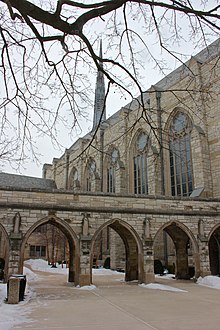
As admissions to colleges and universities grew increasingly competitive in the 1990s and 2000s, President Henry S. Bienen's tenure saw an increase in the number and quality of undergraduate applicants, continued expansion of the facilities and faculty, and renewed athletic competitiveness. In 1999, Northwestern student journalists uncovered information exonerating Illinois death-row inmate Anthony Porter two days before his scheduled execution. The Innocence Project has since exonerated 10 more men.[38][39] On January 11, 2003, in a speech at Northwestern School of Law's Lincoln Hall, then Governor of Illinois George Ryan announced that he would commute the sentences of more than 150 death-row inmates.[40]
In the 2010s, a five-year capital campaign resulted in a new music center, a replacement building for the business school, and a $270 million athletic complex.[41][42] In 2014, President Barack Obama delivered a seminal economics speech at the Evanston campus.[43] In 2015, Queen Máxima and King Willem-Alexander of the Netherlands visited Northwestern to announce research collaborations between Northwestern and several Dutch institutions focused on the study of aging.[44] In 2021, an additional $480 million, the largest donation in the university's history, was donated to Northwestern by the Ryan Family to be applied to research at the Kellogg School of Management and Feinberg School of Medicine, as well as for renovating Ryan Field.[45] In a partnership with Oakton College and the Illinois Department of Corrections in 2023, Northwestern awarded the first bachelors degrees in the United States to a graduating class of prisoners from a top-ranked university.[46]
Campuses
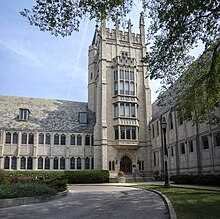
Evanston
Northwestern University's main campus is located in the suburb of Evanston, Illinois, just north of Chicago. The campus spans an area of 240 acres and is characterized by its blend of modern and historic gothic architecture.
Northwestern's Evanston campus, where the undergraduate schools, the Graduate School, and the Kellogg School of Management are located, runs north–south from Lincoln Avenue to Clark Street west of Lake Michigan along Sheridan Road. North Campus is home to the fraternity quads, athletics facilities including the Henry Crown Sports Pavilion and Norris Aquatics Center, the Technological Institute, Dearborn Observatory, the Patrick G. and Shirley W. Ryan Hall for Nanofabrication and Molecular Self-Assembly, and the Ford Motor Company Engineering Design Center among others. South Campus is home to the university's humanities buildings, music buildings like the Pick-Staiger Concert Hall, the Mary and Leigh Block Museum of Art, and the sorority quads. In the 1960s, the university created an additional 84 acres (34 ha) for the campus by filling in a portion of Lake Michigan. Buildings located on the resulting Lakefill include University Library, the Patrick G. and Shirley W. Ryan Center for the Musical Arts, the Regenstein Hall of Music, Norris University Center (the student union), the Kellogg School of Management Global Hub, and various athletics facilities.
The Chicago Transit Authority's elevated train running through Evanston is called the Purple Line, taking its name from Northwestern's school color. The Foster and Davis stations are within walking distance of the southern end of the campus, while the Noyes station is close to the northern end of the campus. The Central station is close to Ryan Field, Northwestern's football stadium. The Evanston Davis Street Metra station serves the Northwestern campus in downtown Evanston and the Evanston Central Street Metra station is near Ryan Field. Pace Suburban Bus Service and the CTA have several bus routes that run through or near the Evanston campus.
Chicago
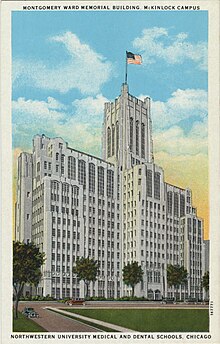
Northwestern's Chicago campus is located in the city's Streeterville neighborhood near Lake Michigan. The Chicago campus is home to the nationally ranked Northwestern Memorial Hospital, the medical school, the law school, the part-time MBA program, and the School of Professional Studies. Medill's one-year graduate program rents a floor on Wacker Drive, across the river from Streeterville and separate from the rest of the campus. Northwestern's professional schools and a number of its affiliated hospitals are located approximately four blocks east of the Chicago station on the CTA Red Line. The Chicago campus is also served by CTA bus routes.
Founded or affiliated at varying points in the university's history, the professional schools originally were scattered throughout Chicago.[48] In connection with a 1917 master plan for a central Chicago campus and President Walter Dill Scott's capital campaign, 8.5 acres (3.44 ha) of land were purchased at the corner of Chicago Avenue and Lake Shore Drive for $1.5 million in 1920.[48][49] Architect James Gamble Rogers was commissioned to create a master plan for the principal buildings on the new campus, which he designed in collegiate gothic style. In 1923, Mrs. Montgomery Ward donated $8 million to the campaign to finance the construction of the Montgomery Ward Memorial Building, which would house the medical and dental schools, and create endowments for faculty chairs, research grants, scholarships, and building maintenance.[50] The building would become the first university skyscraper in the United States.[47] In addition to the Ward Building, Rogers designed Wieboldt Hall to house facilities for the School of Commerce[51] and Levy Mayer Hall to house the School of Law.[52] The new campus comprising these three new buildings was dedicated during a two-day ceremony in June 1927. The Chicago campus continued to expand with the addition of Thorne Hall in 1931 and Abbott Hall in 1939.[48][53] In October 2013, Northwestern began the demolition of the architecturally significant Prentice Women's Hospital. Eric G. Neilson, dean of the medical school, penned an op-ed that equated retaining the building with loss of life.[54]
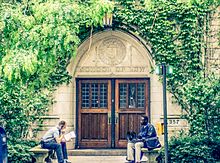
Education City
In Fall 2008, Northwestern opened a campus in Education City, Doha, Qatar.[55] Through the Medill School of Journalism and School of Communication, NU-Q offers bachelor's degrees in journalism and communications respectively.[56] However, some have questioned whether NU-Q can truly offer a comparable journalism program to that of its U.S. campus given Qatar's instances of censorship and strict limits on journalistic and academic freedoms.[55][57] The Qatar Foundation for Education, Science and Community Development, a private charitable institution founded by former emir Sheikh Hamad bin Khalifa Al Thani and his wife and mother of the current emir Sheikha Moza bint Nasser, provided funding for construction and administrative costs, as well as support to hire 50 to 60 faculty and staff, some of whom rotate between the Evanston and Qatar campuses.[58][59] Northwestern receives roughly $45 million per year to operate the campus.[57] In February 2016, Northwestern reached an agreement with the Qatar Foundation to extend the operations of the NU-Q branch for an additional decade, through the 2027–2028 academic year.[60][57][61][62]
Organization and administration
Governance
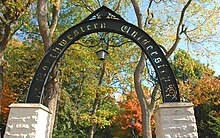
Northwestern is privately owned and governed by an appointed Board of Trustees, which is composed of 70 members and, as of 2022[update], is chaired by Peter Barris '74.[63] The board delegates its power to an elected president who serves as the chief executive officer of the university.[64] Northwestern has had seventeen presidents in its history (excluding interim presidents). The current president, legal scholar Michael Schill, succeeded Morton O. Schapiro in fall 2022.[65] The president maintains a staff of vice presidents, directors, and other assistants for administrative, financial, faculty, and student matters.[66] Kathleen Haggerty assumed the role of provost for the university on September 1, 2020.[67]
Students are formally involved in the university's administration through the Associated Student Government, elected representatives of the undergraduate students, and the Graduate Student Association, which represents the university's graduate students.[68][69]
The admission requirements, degree requirements, courses of study, and disciplinary and degree recommendations for each of Northwestern's 12 schools are determined by the voting members of that school's faculty (assistant professor and above).[70]
Endowment
Northwestern maintains an endowment of $16.1 billion, the eighth-largest university endowment among private universities in the United States.[71] The endowment is sustained through donations and is maintained by investment advisers at the university's Investment Office.[72]
Academics
| Undergraduate and graduate schools | Graduate and professional |
|---|---|
Evanston Campus
|
Evanston Campus
Chicago Campus
|
Admissions
| Undergraduate admissions statistics | |
|---|---|
| Admit rate | 7.2% ( |
| Yield rate | 56.5% ( |
| Test scores middle 50%[i] | |
| SAT Total | 1500–1560 ( |
| SAT EBRW | 730–770 ( |
| SAT Math | 760–790 ( |
| ACT Composite | 33–35 ( |
| High school GPA[ii] | |
| Top 10% | 94.0% ( |
| Top 25% | 98.0% ( |
| Average | 4.1 ( |
Northwestern University's admissions are characterized as "most selective" by U.S. News & World Report.[75] Northwestern received a record 52,225 applications for its class size of approximately 2,100 students in 2022–2023 academic year. For the Class of 2027, regular decision acceptance rate was approximately 4.6%, while overall acceptance rate remained around 7.0%.[76] For the Class of 2026, the interquartile range (middle 50%) on the post-2016 SAT was a combined (verbal and math) 1500–1560 out of 1600; the interquartile range on the evidence-based reading and writing (EBRW) section of the SAT was 730–770 out of 800 while the interquartile range on the Math section of the SAT was 760–800 out of 800.[77] ACT composite scores for the middle 50% ranged from 33 to 35 out of 36, and 96% ranked in the top ten percent of their respective high school classes.[76][78][77]
Approximately 35–40% percent of the incoming students of the Class of 2027 have been admitted through the Early Decision application round. Northwestern's early decision admission numbers for the Class of 2027 reveal an early acceptance rate of about 20%, with approximately 1,000 students being admitted out of 5,220 applications.[79]
In April 2016, Northwestern became one of 15 Illinois universities to sign on to the Chicago Star Partnership, a City Colleges initiative aimed at increasing opportunities for students in the city's public school district. Through this partnership, the university provides scholarships to students who "graduate from Chicago Public Schools, get their associate degree from one of the city's community colleges, and then get admitted to a bachelor's degree program."[80]
The university is need-blind for domestic applicants.[81]
Rankings and reputation
| Academic rankings | |
|---|---|
| National | |
| ARWU[82] | 20 |
| Forbes[83] | 18 |
| U.S. News & World Report[84] | 9 (tie) |
| Washington Monthly[85] | 31 |
| WSJ/College Pulse[86] | 25 |
| Global | |
| ARWU[87] | 30 |
| QS[88] | 50 (tie) |
| THE[89] | 28 |
| U.S. News & World Report[90] | 24 |
Northwestern is a large, residential research university.[91]
Education
The university provides instruction in over 200 formal academic concentrations, 124 undergraduate programs, and 145 graduate and professional programs,[92][93] including various dual degree programs.[94][95] Although there is no university-wide core curriculum, a foundation in the liberal arts and sciences, sometimes referred as distribution requirements, are required for all majors; individual degree requirements are set by the faculty of each school.[70] The university heavily emphasizes interdisciplinary learning, with 72% of undergrads combining two or more areas of study.[96] Northwestern's full-time undergraduate and graduate programs operate on an approximately 10-week academic quarter system with the academic year beginning in late September and ending in early June. Under the regular academic calendar, each quarter contains a four-day Reading Period in between the end of classes and the beginning of finals.[97] Undergraduates typically take four courses each quarter and twelve courses in an academic year and[98] are required to complete at least twelve quarters on campus to graduate. Northwestern offers honors, accelerated, and joint degree programs in medicine, science, mathematics, engineering, and journalism.[99] The comprehensive doctoral graduate program has high coexistence with undergraduate programs.[91]
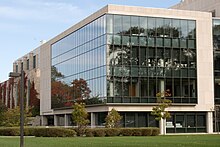
The most popular and prominent majors at Northwestern in 2021 include communication, journalism, engineering, computer science, mathematics, statistics, biological sciences, physics, and chemistry.[94][100] It is also prominent in law and medicine. Northwestern is accredited by the Higher Learning Commission and the respective national professional organizations for chemistry, psychology, business, education, journalism, music, engineering, law, and medicine.[101] Northwestern conferred 2,190 bachelor's degrees, 3,272 master's degrees, 565 doctoral degrees, and 444 professional degrees in 2012–2013.[needs update] Since 1951, Northwestern has awarded 520[needs update] honorary degrees.[102][103] Northwestern also has chapters of academic honor societies such as Phi Beta Kappa (Alpha of Illinois), Eta Kappa Nu, Tau Beta Pi, Eta Sigma Phi (Beta Chapter),[104] Lambda Pi Eta,[105] and Alpha Sigma Lambda (Alpha Chapter).[106]
Northwestern maintains a student-to-faculty ratio of 6:1. 77% of the classes have less than 20 students while 5.5% of the classes have more than 50 students.[94]
Libraries and museums
The Northwestern library system consists of four libraries on the Evanston campus including the Main University Library, the Boas Mathematics Library, Mudd Library, and the original library building, Deering Library; three libraries on the Chicago campus; and the library affiliated with Garrett-Evangelical Theological Seminary.[107] Northwestern Libraries host a total of 8,198,268 printed or electronic volumes.[108] In addition, its libraries contain 229,198 maps, 211,127 audio files, 103,377 printed journals, 196,716 electronic journals, 91,334 movies or videos, 36,989 manuscripts, 4.6 million microforms, and almost 99,000 periodicals.[108] The University Library is the 14th-largest university library in North America based on total number of titles held.
Collections and sections
Among the library's collection and sections are:
- Melville J. Herskovits Library of African Studies: established in 1954, and named after Melville J. Herskovits, the Herskovits Library is the largest separate Africana collection in existence. The collection includes more than 400,000 volumes (including 20,000 in African languages), 250 current newspapers and 6,000 non-circulating rare books.[109]
- The Music Library: contains extensive holdings of printed music and archival materials documenting music composed since 1945. The collection includes more than 300,000 items, including the John Cage collection.
- Transportation Library: one of the largest transportation information centers in the world with a collection of over 500,000 items covering air, rail, highways, pipeline, water, urban transport and logistics.
- The Art Library: the Art Library holds over 160,000 books and journals about art, architecture, and design, with particular strength in 19th-century art and architecture.
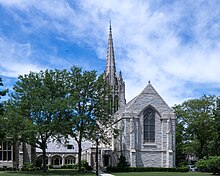
Seabury Hall houses some sections of the Styberg Library - Styberg Library: the theological library serves the Garrett–Evangelical Theological Seminary and Bexley Seabury.
- Charles Deering McCormick Library of Special Collections include an extensive collection on The Long 60s, Social History, Political History, Literature, Arts, Journalism, Twentieth Century Music, Theatre, Performance, and Women's History.[110] The Special Collections department at Charles Deering McCormick Library holds approximately 8,000 items related to the Siege and Commune of Paris during 1870–1871. This collection is one of the largest and most diverse of its kind in the world and contains a captivating range of original photographs, posters, caricatures, lithographs, manuscripts, books, newspapers, and other artifacts that were created in response to the significant events that occurred during that year. These events included France's defeat in the Franco-Prussian War, the downfall of the Second Empire, the four-month siege of Paris, and the violent civil war that ended the Commune uprising. The core of the collection was acquired in 1971, the centenary year of the Commune's end, when the library's astute staff purchased most of the offerings of a well-known French book dealer. Since then, many other acquisitions have been added to the collection. The Franco-Prussian War was among the earliest conflicts to be photographed, and the collection includes many such images, along with depictions of the devastated Parisian landscape and some of the earliest examples of manipulated photographs created for propaganda purposes.[111] The collection also encompasses a significant amount of material that covers military activities during the Spanish Civil War and the early stages of World War II from both sides of the conflict. In addition, the collection showcases the impact of warfare on civilians who were displaced or killed in various parts of Spain, including any interactions with France and Germany during that period. The collection also features various other topics that offer insight into Spain's cultural and social dynamics throughout history. The photographs in the collection were sourced from international press outlets and private collections and are accompanied by captions that provide historical background and context for the subjects depicted.[112]
- Northwestern University Archives Pritzker Legal Research Center: the library is located on the Chicago campus and serves the Northwestern University Pritzker School of Law.
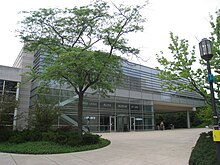
Mary and Leigh Block Museum of Art - Seeley G. Mudd Library: Located on North Campus, Mudd Library was renovated in 2017 with collaboration and technology in mind.
- Charles Deering Memorial Library: built in 1933, and named for Charles Deering, the library houses the art library, the Charles Deering McCormick Library of Special Collections, the Music Library and University Archives.
- Boas Mathematics Library: the library serves primarily the Mathematics Department and Statistics Department and has a research collection in pure mathematics and statistics of around 34,000 volumes.
- The Mary and Leigh Block Museum of Art, a major art museum in Chicago, contains more than 4,000 works in its permanent collection. It dedicates a third of its space to temporary and traveling exhibitions.[113]
- The Holocaust Educational Foundation, which had previously endowed the Theodore Zev Weiss – Holocaust Educational Foundation Professorship in Holocaust Studies, became part of Northwestern in 2011.[114][115]
Northwestern, along with 15 other universities, participates in digitizing its collections as part of the Google Book Search project.[116] Northwestern University Library is a partner with the Native American Education Services College (NAES), the American Indian Association of Illinois (AIAI), and Northwestern University's Center for Native American and Indigenous Research in the NAES College Digital Library Project, which preserves the NAES College library and archives.[117]
Research and innovations
Research
Northwestern was elected to the Association of American Universities in 1917 and is classified as an R1 university, denoting "very high" research activity.[91][118] Northwestern's schools of management, engineering, and communication are among the most academically productive in the nation.[119] The university received $923.8 million in research funding and $421 million in NIH funding in 2022 and houses over 90 school-based and 40 university-wide research institutes and centers.[78][120][121] Northwestern also supports nearly 1,500 research laboratories across two campuses, predominantly in the medical and biological sciences.[121]Also, Northwestern houses more than 50 University Research Institutes & Centers (URICS), which consists of institutes and initiatives that combine multiple areas of study to pursue research across domains such as quantum information, policy research, bioelectronics, and more.[122][123]
Northwestern is home to the Center for Interdisciplinary Exploration and Research in Astrophysics, Northwestern Institute for Complex Systems, Nanoscale Science and Engineering Center, Materials Research Center, Center for Quantum Devices, Institute for Policy Research, International Institute for Nanotechnology, Center for Catalysis and Surface Science, Buffet Center for International and Comparative Studies, the Initiative for Sustainability and Energy at Northwestern,[124] and the Argonne/Northwestern Solar Energy Research Center among other centers for interdisciplinary research.[125]
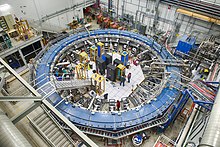
The university also shares collaborative research efforts with other universities such as the CZ Biohub Chicago with the University of Chicago and University of Illinois.[126]
In addition, Northwestern University cooperates with research institutions such as Argonne National Laboratory and Fermi National Accelerator Laboratory (FermiLab). Proceeding in cooperation with these laboratories, the Center for Applied Physics and Superconducting Technologies (CAPST) and the Initiative at Northwestern for Quantum Information Research and Engineering (INQUIRE) have attracted attention in recent years.[127][128] Northwestern's investment and collaboration areas include particle physics, quantum physics, quantum information technologies, and superconducting technologies.
Innovations and entrepreneurship
In 2013, Northwestern researchers disclosed 247 inventions, filed 270 patent applications, received 81 foreign and US patents, started 12 companies, and generated $79.8 million in licensing revenue. The Innovation and New Ventures Office (INVO) has been involved in creating the Center for Developmental Therapeutics (CDT)[129] and the Center for Device Development (CD2).[130]
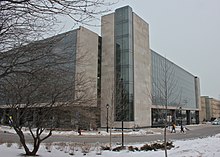
Northwestern files hundreds of patents each year, ranking among the top 20 universities in the world in terms of U.S. utility patents.[131] One of the university's most successful current patents is pregabalin, a synthesized organic molecule developed at the university by chemistry professor Richard Bruce Silverman (for whom Silverman Hall was named). It was ultimately marketed as Lyrica, a drug sold by Pfizer, to combat epilepsy, neuropathic pain, and fibromyalgia.
Northwestern has an extensive history of producing prominent businessmen and entrepreneurs. Companies founded by Northwestern alumni include Groupon, The Blackstone Group, Booz Allen Hamilton, U.S. Steel, Kirkland & Ellis, Guggenheim Partners, Accenture, Aon Corporation, and AQR Capital.
The university also runs The Garage, and interdisciplinary innovation and entrepreneurship space and community for student-run startups. The Garage provides students with resources and programming related to entrepreneurship and mentorship.[132] The Garage houses approximately 90 student-founded startups per academic quarter.[133] Its programs and resources are available to all Northwestern students.
Student life
Student body
| Race and ethnicity[134] | Total | ||
|---|---|---|---|
| White | 42% | ||
| Asian | 19% | ||
| Hispanic | 13% | ||
| Foreign national | 10% | ||
| Other[a] | 9% | ||
| Black | 6% | ||
| Economic diversity | |||
| Low-income[b] | 20% | ||
| Affluent[c] | 80% | ||
Text je dostupný za podmienok Creative Commons Attribution/Share-Alike License 3.0 Unported; prípadne za ďalších podmienok. Podrobnejšie informácie nájdete na stránke Podmienky použitia.
Antropológia
Aplikované vedy
Bibliometria
Dejiny vedy
Encyklopédie
Filozofia vedy
Forenzné vedy
Humanitné vedy
Knižničná veda
Kryogenika
Kryptológia
Kulturológia
Literárna veda
Medzidisciplinárne oblasti
Metódy kvantitatívnej analýzy
Metavedy
Metodika
Text je dostupný za podmienok Creative
Commons Attribution/Share-Alike License 3.0 Unported; prípadne za ďalších
podmienok.
Podrobnejšie informácie nájdete na stránke Podmienky
použitia.
www.astronomia.sk | www.biologia.sk | www.botanika.sk | www.dejiny.sk | www.economy.sk | www.elektrotechnika.sk | www.estetika.sk | www.farmakologia.sk | www.filozofia.sk | Fyzika | www.futurologia.sk | www.genetika.sk | www.chemia.sk | www.lingvistika.sk | www.politologia.sk | www.psychologia.sk | www.sexuologia.sk | www.sociologia.sk | www.veda.sk I www.zoologia.sk




